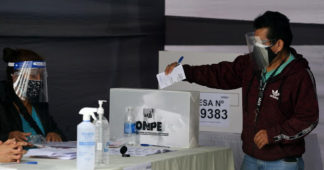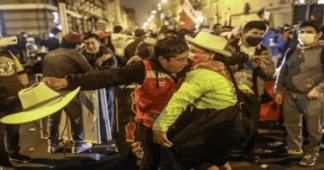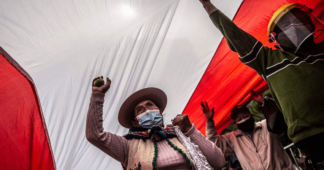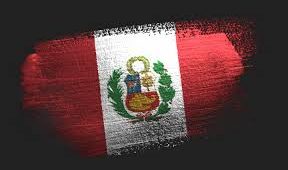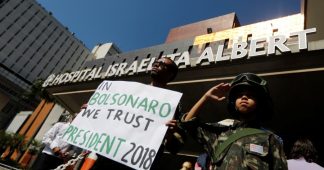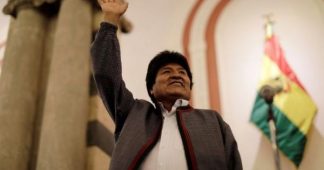By Francisco Dominguez
Primary school teacher from Peru’s rural Cajamarca, Pedro Castillo, has been elected president of this South American nation in a hotly fought election.
With 100% of the votes counted, Castillo, candidate of left-wing coalition Peru Libre, won with 50.14 % of the votes, against Keiko Fujimori, daughter of infamous and disgraced corrupt dictator, Alberto Fujimori and right-wing candidate of Fuerza Popular, a coalition supported by the country’s oligarchic elite, obtained 49,86%.
To many, Castillo’s electoral robust performance in the first round with 18% of the vote was a surprise, since up to that point, the main contender for the left was Veronika Mendoza, candidate of the Juntos por el Peru coalition, who obtained slightly less than 8%. Below we examine the main events and developments that would culminate in this extraordinary victory for the Peruvian and Latin American Left.
The ongoing crisis of legitimacy
As it typifies oligarchic rule in Latin America, whenever the elite faces a serious challenge to its dominance it resorts to authoritarian methods, including brutal repression and if need be, mass murder. This is what the Peruvian elite did when in the early 1990s it faced mass opposition to the imposition of neoliberal impoverishment; one of the most extreme manifestations of opposition was the Shining Path guerrilla insurgency. State repression was substantially intensified with the election of Alberto Fujimori as president in 1990.
Fujimori’s dictatorial regime lasted a full decade (1990-2000) but it fell under the weight of its own corruption, engulfed in a constitutional crisis of legitimacy caused by his contempt for democratic procedure: he closed down congress, usurped judicial authority, promulgated a neo-liberal constitution and governed brutally and autocratically. He is currently serving a 25-year prison sentence for his role in killings and kidnappings by death squads during his government’s military campaign against leftist guerrillas.
Fujimori’s successor, president Alejandro Toledo (2001-2006) fared no better, even though, unlike Fujimori, he did not resort to underhand and brutal methods during his presidency. Nevertheless, he is under house arrest in San Francisco, awaiting extradition on charges of receiving multimillionaire bribes.
Then it was the turn of Alan Garcia, leader of APRA, an originally progressive populist party, who succeeded Toledo for the period 2006-2011, and who committed suicide in 2020 as the police came to arrest him for personal graft and corruption during his administration.
Ollanta Humala, briefly depicted as a sort of Peruvian Chavez and even publicly supported by the Comandante himself, defeated Keiko Fujimori at the 2011 elections thereby becoming the country’s president for the 2011-2016 period. But at it seems to befit Peru’s presidents, in 2017 he and his wife were arrested on charges of corruption and money laundering associated with it. Both are banned from leaving Peru and are awaiting trial.
The 2017 election crowned Pedro Pablo Kuczynski as the country’s president for 2016-2021, but he was not to break with the ‘cultural tradition’ and was forced to resign in 2018 (to avoid impeachment procedures began in 2017) for lying to congress and for receiving bribes in exchange for government contracts. Kuczynski also claimed to suffer from heart problems (as Fujimori, Toledo and Humala have done) thus benefiting from house arrest. It is evident that being the tenant of the House of Pizarro (the popular name for Peru’s presidential palace) is a tough job full of so many exciting incentives that can gravely affect their cardiac system.
Kuczynski had to be replaced by his vice-president, Martin Vizcarra, who launched an offensive against corruption but was impeached by congress in November 2020 for taking bribes on several occasions in 2014 in exchange for awarding public work contracts. It is widely believed his impeachment was prompted by his decision to close down congress for obstructing the investigations against corruption.1
Vizcarra (who has not as yet claimed heart problems) accepted the congress decision and was replaced by the Congress’s President, Manuel Merino, as caretaker leader with a cabinet dominated by the business elite. Merino’s brief 6-day government sent strong hints of ignoring popular demands for the reform of the political and judicial systems and even entertained postponing the scheduled 2021 elections justified by the problems brought about by the Covid-19 pandemic.
The country exploded in huge mass demonstrations that were met by brutal police repression with two dead, dozens injured and many more arrested. Merino was forced to resign on 15 November 2020 and Congress then appointed Francisco Sagasti (who had voted against Vizcarra’s impeachment) as interim president, and was entrusted with the task of organising the presidential elections in April 2021.
Thus since Peru’s elite had for decades undermined the rule of law and the credibility of the nation’s institutions, the state key positions had been filled in by corrupt or corruptible members of the political class (involving all mainstream political parties), in a system overwhelmingly dominated by finance capital, mining concerns, raw materials exporters, one media monopoly, and multinational companies. These powerful groups pay almost no taxes whilst taking away the nation’s wealth, leaving the agricultural sector in a state of total neglect. Such was the context surrounding the election that elected Pedro Castillo as president of Peru.
The consequences of Peru’s neoliberal dictatorship
In the last two decades, the country’s economic performance has been impressive receiving praise from the IMF: “Peru continues to be one of the best-performing Latin American economies. With annual real GDP growth averaging 5.4 percent over the past fifteen years, Peru has been one of the fastest-growing economies in the region, which enabled it to make significant progress in reducing poverty.”2
However, a deeper look into it produces a different impression. In 1970 Peru’s level of poverty was 50%, and by 2000 had slightly increased to 54.1%;3 by 2006 poverty had barely declined to 49.1%, and though it went down to about 20% in 2019, with the pandemic it has gone right back up to 30%4. In short, half of the country’s population have remained in a state of poverty for almost two generations and about one third for the last decade. However, 30% is deceptive since the level of labour informality in the country’s economy is a staggering 70%, of people who live day to day as street vendors; they and their families have gone hungry during the lockdown.5
The two decades of macroeconomic economic success and social horror correlate to the coming to office of Alberto Fujimori who successfully defeated Mario Vargas Llosa’s comprehensive neoliberal privatisation plan, at the 1990 election. Fujimori’s government systematised the use of counterinsurgency state terror to purge society from rebellious constituencies, such as those in the Sierra (Peru’s highlands), inhabited predominantly by indigenous people. Already by the end of the 1980s the departments of Ayacucho, Apurimac and Huancavelica were under martial law.
The military campaign against the Left was aided by the combination of extreme sectarianism, intense dogmatism, and the insurrectionary and violent methods practised by the Shining Path, a splinter group from the Communist Party. They enjoyed strong support precisely in the highlands departments mentioned and by the early 1990s had made considerable inroads into Lima’s shanty towns not only challenging the state but also waging a vicious campaign against the rest of the country’s Left.
The government response was the Fujimorazo, a self-coup carried out on 5 April 1992, with the president dissolving Congress and dismantling the judiciary, assuming full executive and legislative powers. He also used these powers to decree stringent and repressive labour laws that destroyed the remnants of an already seriously weakened labour movement. Under Fujimori labour legislation was crafted so as to make Peru a paradise of labour flexibility, management’s right to fire, casualization of labour contracts and workers’ unionisation and collective bargaining action, difficult.6
By 1993 Fujimori had increased the provinces under a military state of emergency from 52 to 66 and by 1994, nearly half of the population lived in such zones, areas where the security forces repressed the whole of the Left not just the Shining Path. It is estimated that by 1995 “insurgents, state security forces, drug traffickers, death squads, and civilian paramilitaries had killed more than 27,000 Peruvians.” And according to Peru’s Truth and Reconciliation Commission the number of fatal victims of internal strife between 1980 and 2000 was 69,000.7 Peru had become a killing field.
The brutal state counterinsurgency offensive launched in 1980 had not only halted but also reversed the development of a Left that was becoming politically and electorally stronger. In the 1980 election it had obtained a combined vote of about 12-15%, though divided between 5 candidates, but in the 1985 election, a united left candidate got an impressive 24%. However, in the 1990 election the Left went down to 12% split between two candidates; it had almost no presence in the elections in 1995, 2000, 2006, and 2011 and began to painfully recover only in 2016.
Fujimori’s 1993 neoliberal structural reforms (the ‘Fuji-shock’) included the elimination of price controls, total deregulation of markets, privatisation of state-owned companies and activities, and a tight monetary policy. The privatisation programme attracted foreign investment (particularly from the US) in natural resources, finances and consumer markets. This resulted in intense concentration of ownership by foreign concerns thereby shrinking the influence and leverage of national industrial capital.8
Over time the country’s income distribution drastically worsened thus by 2019 the top 1% and 10% of income earners got 29.6% and 56.6% of GDP, respectively; 40% of middle income earners got 35.8% of GDP, whilst 50% of low income earners only received 9.4% of GDP; one of the most unequal in the world.9 No wonder Covid-19 has wreaked havoc among the poor, since one lockdown day at home for the 70% working in the informal sector (this is millions of people and their families), means one day without income. Decades of neoliberal privatisation and cuts in state expenditure (health, education and the like) having thrown millions into precariousness and hardship made them the unavoidable victims of Covid-19: by 4 June Peru had the highest mortality rate in the world per million people (188,000 with 1,998,056 confirmed cases).10
Castillo’s Long March
It was reported that when it was announced that a teacher had won the first round of elections, the staff at CCN scrambled to obtain information about, and get hold of a photo of Pedro Castillo because they did not have even a picture of him in their database. How did Pedro Castillo and Peru Libre, managed to win the presidency, even though by a whisker? Castillo’s manifesto makes it even more puzzling since the key tenets of his government programme include a frontal attack on neoliberalism, proposes the election of a Constituent Assembly to draft and promulgate a new constitution to substitute the dominant neoliberal economic model, land reform, the nationalisation of the nation’s natural resources ensuring most of the wealth they produce remains in Peru so as to eradicate poverty, increase state expenditure on social services (health and education), and implement income redistribution.11 Even worse (or better) Castillo declares himself a Marxist and a mariateguista (follower of Peruvian intellectual, Jose Carlos Mariátegui, perhaps one the most original and influential Latin American Marxist thinkers).12
The Partido Nacional Peru Libre (PNPL) places political emphasis on the specific demands of Peru’s peasantry: land reform, social rights, education and health, thus expressing the demands and aspirations of the deep, rural, indigenous Peru. Mariátegui, writing in the 1920s, posited there would not be bourgeois revolution in Peru because there was no social class interested in carrying it out, thus the only concrete possibility of society’s structural transformation would come from a socialist revolution, the precondition of which was bringing in the indigenous people as a fundamental agent of such change.
This framework is still basically correct in 2021 Peru. Keiko Fujimori got strong support in key cities (for example, Lima and Callao, with 65% and 67%, respectively), but Castillo got a landslide in the Andean (indigenous) provinces such as Puno (89%), Huancavelica (85%), Cusco (83%), Ayacucho (82%), Apurimac (81%), Moquegua (73%), Cajamarca (71%), Huánuco (68%), and Pasco (66%). It was an indigenous victory13 that is not identical to a victory of rural against urban Peru, as some in the media have portrayed Castillo’s victory. After all, 73% of the population live in cities whilst only 27% live in rural areas, that is, the Marxist teacher could not have won without substantial support in the urban centres. The validity of the PNPL central tenet of refounding the nation as a Plurinational State along the basic lines of Ecuador and Bolivia is therefore undeniable: in Peru there are 4 indigenous languages in the Andes (Quechua, Aymara, Cauqui and Jaqaru) and 43 more in the Amazon region, 500 years after the Spanish Conquest.
The implementation of brutal neoliberal policies coupled with the DEA-inspired ‘war on drugs’ principally in the Amazon region (La Selva) from the 1990s onwards, meant that communities in Amazonia suffered the brunt of the ‘dirty war’ against the Shining Path and the army-led fight against drug trafficking, whilst in the Andes, indigenous communities were further marginalised by aggressive mining from the operation of multinational companies. The racism that supplemented these twin aggressions led to organised resistance and, therefore, to the rise of popular, communitarian and indigenous leaderships.
Hence, for example the election of some of these emerging leaders to the governorships of Puno, Junín and Moquegua. Many more such leaders were elected to lead provinces and municipalities with teachers playing a protagonist role in them (Castillo himself had been mayor of his town, Anguía, in Cajamarca).14 Thus, resulting from a decades-long political development, PNPL is a well-organised, militant, political outfit with strong territorial support in key areas, and with solid association and collaboration with peasant and indigenous communities and organizations (such as the ronderos15), and trade unions, especially, but not exclusively, among teachers. Castillo himself led the 2017 teachers’ strike to defend wages and demand budget increases in education.
In short, the PNPL has had access to local resources, has enjoyed an institutional presence in local, provincial and regional governments, and, since 60% of Peruvians do not have access to internet, for its election campaign it has relied on community radios, personal visits to small towns, and cultural events. Thus, in the context of the 2021 election (first and second rounds) Castillo was not only the outsider, but a breath of fresh air who, in the midst of a criminally managed pandemic and the deep institutional crisis the nation faced, gave hope and voice to the rural and urban downtrodden.16
The tasks ahead
The election result was incredibly tight: 8,883,185 for Castillo against 8,783,765 for Keiko Fujimori. Furthermore, the PNPL got a minority of 37 seats that together with the 5 obtained by Juntos por el Peru, president Castillo will command 42 out of the 130 seats in Congress, whilst Fujimori’s Fuerza Popular and the other right wing electoral coalitions have a combined parliamentary strength of at least 80 seats. The latter, with the full complicity and support of the country’s media, ran an intoxicating electoral campaign of fear charging Castillo with being a Shinning Path sympathiser, a “terruco”, pejorative slang term that means ‘terrorist’ used by Peru’s establishment to stigmatize the Left.
Days before the second round, Keiko deployed arch-reactionary Peruvian writer, Mario Vargas Llosa and Venezuelan extreme right-winger and outlawed coup-monger, Leopoldo Lopez, to support her electoral campaign so as to defeat Castillo’s “communism”. Keiko, with no evidence whatsoever, has persisted in accusing the PNPL of election fraud demanding the annulment of the votes of more than 800 voting points in the country’s interior. Then she mobilised 22 right-wing ex-presidents of Latin America and Spain (with Aznar and Uribe being prominent) who issued a statement making similar allegations, demanding Castillo was not proclaimed the winner. In desperation then, she staged marches to military barracks and to the Ministry of Defence (9 June 2021) to request the military to act to prevent the “victory of communism.” However, barely hours after Castillo proclaimed himself the winner, the Defence Ministry issued a statement confirming the political neutrality of the armed forces and calling for respect for the election results.
Such threats have been met with large demonstrations in Lima and the rest of the country with the ronderos promising a march on Lima if through electoral fraud, Castillo’s electoral victory is stolen. On 22 May 2021 the National Coordination of Army, Navy, Air Force and Police Reservists (Retired) – CONAFAP – issued a strong statement warning against any possible election fraud in the second round and in support of Pedro Castillo. Though it is not clear how strong Castillo’s support may be within the armed forces, there is a historic left-wing nationalist influence in them that stems from the Revolutionary Government of the Armed Forces led by General Juan Velasco Alvarado (1968-1975)17; many of PNPL’s proposals strongly resemble those of Velasco.
With his clean victory, Castillo and his programme of progressive structural change are now being noticed by millions of the poor in the main urban centres, particularly Lima (with 10 million out of a total population of 32). The more his government engages, mobilises and commits to the poor in supporting the implementation of his policies, the greater the chances of being adopted by them as their own political social objectives. This will allow him to prepare the ground for a referendum for a Constituent Assembly to draft an anti-neoliberal constitution as the basis for the creation of a Plurinational State, the premise for the carrying out of a mariateguista socio-economic transformation of Peru.
Contrary to media misrepresentation, the PNLP programme also includes, among many other interesting policies, the decriminalisation of abortion, a head-on attack on the traffic of persons – especially women, the elimination of patriarchy and machismo in state and society, the respect and promotion of women’s reproductive rights and the promotion of the self-organization of women at every level.18 This contrasts sharply with Keiko’s defence of her father’s legacy that among other stains, has his Eugenic plan that led to the forcible sterilization of about 350,000 mainly peasant and indigenous women carried out to deal with the nation’s ‘Indian problem’ (higher birth rates among indigenous people than Peruvians of European descent).19
Castillo’s immediate concern is to ensure a smooth transition of presidential power to guarantee the country’s governability, prevent a run on the currency, prevent financial panic, violent street demonstrations, destabilisation plans and such like that have characterised many electoral victories of presidential candidates of the Left in Latin America. A major cause for concern is the Biden administration’s ‘Trumpian inertia’, maintaining pretty much unchanged US’s aggression against governments of the left in the region of his predecessor, despite his promise to, for example, restore Obama’s constructive policies towards Cuba.
On the other hand, the coming Peru Libre administration does and will benefit from a changing relation of forces for the better in the region with robust left victories in neighbouring Argentina, Chile and especially Bolivia. Castillo has already received the open support of Nicaragua, Mexico, Cuba and from the mass parties of the Latin American Left organised in the Sao Paulo Forum and the Puebla Group, with the latter two issuing strong statements of support calling to respect the will of the Peruvian people. Castillo has also in his favour, the visible deterioration of the US regional machinery of intervention with Luis Almagro, Secretary General of the Organization of the American States (OAS), suffering massive discredit after his disgraceful and criminal complicity in the coup d’état that ousted Evo Morales in 2019 and facing a criminal accusation from Bolivia in the International Criminal Court. He has been openly and publicly repudiated by the governments of Argentina and Mexico, and with the US-inspired Lima group (set up to overthrow the Bolivarian government of Venezuela and led by Almagro) just having lost Lima to a party whose programme includes Peru leaving the OAS and going back to UNASUR. To top it all, the PNLP programme includes strong support for Cuba and Venezuela.
Our job in the imperialist North is to tell the truth about Pedro Castillo’s progressive, anti-neoliberal programme aimed at reversing decades of neoliberal policies to support his beleaguered nation and people by counteracting the unavoidable mainstream media misrepresentations; to remain vigilant and denounce and reject any external or domestic attempt to undermine the victory of the people of Peru by foul means (violence, coup d’état, lawfare, economic blockade, extra-territorial legislation, sanctions, the usual European Union shenanigans, and such like); and to help construct the broadest solidarity movement in their support.
1 Milan Sime Martinic, The curious case of Peru’s persistent president-to-prison politics, The Week, 17 November 2020.
2 Peru, IMF Country Report No. 20/3, 10th Jan 2020,
3 Carlos Parodi Trece, “Perú: Pobreza y políticas sociales de la década de los 90”, Revista de Ciencias Sociales, Vol. VI, No.3, Sept-Dec. 2001, p.385.
4 Covid-19 and its impact on Poverty in Peru, Project Peru, 10th Jan 2021
5 Whitney Eulich, ‘We’re invisible’: Peru’s moment of reckoning on informal workers, The Christian Science Monitor, 30 June 2020
6 Bart-Jaap Verbeek, “Globalisation and Exploitation in Peru: Strategic Selectivities and the Defeat of Labour in the US-Peru Trade Promotion Agreement”, Global Labour Journal, Vol. 5, 31 May 2014, p.223-4.
7 Eduardo Silva, Challenging Neoliberalism in Latin America, Cambridge University Press, New York, 2009, pp. 236-245.
8 Bart-Jaap Verbeek, op.cit., p.221.
9 Income Inequality, Peru, 1980-2019,World Inequality Database, https://wid.world/country/peru/
10 Situation in Peru remains critical as world’s worst-hit COVID-19 country, Medecins Sans Frontiers, 4 June 2021, https://www.msf.org/peru-covid-situation-remains-critical-worst-hit-country
11 Plan de Gobierno de 100 días de Perú Libre: Los siete ejes de la propuesta, Gestión, 16 May 2021, https://gestion.pe/peru/politica/plan-de-gobierno-de-100-dias-de-peru-libre-los-siete-ejes-de-la-propuesta-noticia/
12 For an analysis of Mariátegui’s significance in Latin America see Francisco Dominguez, “Marxism and the Peculiarities of Indo-American Socialism”, in Mary Davis (ed.), MARX200 The Significance of Marxism in the 21st Century, Praxis Press 2019, pp.49-58.
13 Gilberto Calil, Mariátegui y la elección de Pedro Castillo en Perú, Rebelión, 9 June 2021, https://rebelion.org/mariategui-y-la-eleccion-de-pedro-castillo-en-peru/
14 The Aymara ecologist, Walter Aduviri Calisaya, was elected governor of Puno and current PNPL general secretary, Vladimir Cerrón, its key Marxist intellectual, was elected governor of Junín, but the élite resorting to lawfare, managed to imprison Aduviri, who served 8 years in prison, and Cerrón was suspended as a governor and was banned from being a presidential candidate.
15 Peasant, indigenous and communitarian self-defense organization present in the country that has exponentially grown in the last 10 years; it is claimed that it can mobilize two and half million people; Castillo was an active member.
16 Lautaro Rivara y Gonzalo Armúa, “Pedro Castillo y el Perú: Lo nuevo viene de lejos”, Todos Los Puentes, 15 April 2021, https://todoslospuentes.com/2021/04/15/pedro-castillo-y-el-peru-lo-nuevo-viene-de-lejos/
17 See the insightful analyses in Carlos Aguirre & Paulo Drinot (eds.), The Peculiar Revolution, Rethinking The Peruvian Experiment Under Military Rule, University of Texas Press, 2017.
18 See (in Spanish) especially Chapter XVI, The Socialist Woman, https://perulibre.pe/wp-content/uploads/2020/03/ideario-peru-libre.pdf; in interview Castillo said he personally was against abortion, but was prepared to bring the issue to the proposed Constituent Assembly to be discussed.
19 Anastasia Moloney, Haunted by forced sterilizations, Peruvian women pin hopes on court hearing, Reuters, 8 January 2021, https://www.reuters.com/article/peru-women-sterilizations-idUSL8N2JH4WB
Published at prruk.org
